On the Strength of a 316L-Type Stainless Steel Subjected to Cold or Warm Rolling Followed by Annealing
Abstract
1. Introduction
2. Materials and Methods
3. Results
3.1. Microstructure Evolution
3.2. Tensile Behavior
4. Discussion
4.1. Annealing Behavior
4.2. Structural Strengthening
5. Conclusions
- The austenite reversal (in the cold rolled samples) and continuous recrystallization followed by grain growth led to the UFG microstructures with a grain size of about 0.5 μm and a dislocation density of about 1015 m−2 after annealing at 973 K of the cold or warm rolled 316L-type steel. These UFG microstructures led to a combination of high yield strength (σ0.2 > 900 MPa) and satisfactory plasticity (δ > 15%).
- A power law function was obtained between the grain size (D) and the dislocation density (ρ) in the form of D ~ ρ−0.5 for the UFG 316L-type steel processed by cold or warm rolling and subsequent annealing. The observed relationship meets the model conditions for normal grain growth along with dislocation annihilation recovery.
- The yield strength could be expressed by a modified Hall-Petch-type relationship including a term for dislocation strengthening, assuming that the strength contributions from grain boundaries and dislocations are independent and linearly additive. Taking the mutual relationship between the grain size and the dislocation density, the yield strength could be accurately evaluated by using a single arbitrary selected structural parameter.
Author Contributions
Funding
Conflicts of Interest
List of Abbreviations and Symbols
| CR | Cold rolling |
| CSL | Coincident site lattice |
| EBSD | Electron back scattering diffraction |
| GOS | Grain orientation spread |
| KAM | Kernel average misorientation |
| ND | Normal direction |
| OIM | Orientation imaging microscopy |
| TD | Transverse direction |
| TEM | Transmission electron microscope |
| UFG | Ultrafine-grain |
| UTS | Ultimate tensile strength |
| WR | Warm rolling |
| b | Burgers vector |
| D | Grain size |
| d | OIM step size |
| Ky | Grain size strengthening factor |
| r | Radius of boundary curvature |
| G | Shear modulus |
| V | Rate of grain boundary migration |
| VA | Atomic volume |
| α | Numerical factor |
| γ | Boundary surface energy |
| δ | Total elongation |
| ρ | Dislocation density |
| σ0.2 | Yield strength |
| σ0 | Strength of dislocation-free single crystal |
| τ | Annealing time |
References
- Lo, K.H.; Shek, C.H.; Lai, J.K.L. Recent developments in stainless steels. Mater. Sci. Eng. R Rep. 2009, 65, 39–104. [Google Scholar] [CrossRef]
- Valiev, R.Z.; Islamgaliev, R.K.; Alexandrov, I.V. Bulk nanostructured materials from severe plastic deformation. Prog. Mater. Sci. 2000, 45, 103–189. [Google Scholar] [CrossRef]
- Odnobokova, M.; Belyakov, A.; Kaibyshev, R. Grain refinement and strengthening of austenitic stainless steels during large strain cold rolling. Philos. Mag. 2019, 99, 531–556. [Google Scholar] [CrossRef]
- Kumar, B.R.; Sharma, S.; Mahato, B. Formation of ultrafine grained microstructure in the austenitic stainless steel and its impact on tensile properties. Mater. Sci. Eng. A 2011, 528, 2209–2216. [Google Scholar] [CrossRef]
- Misra, R.D.K.; Nayak, S.; Mali, S.A.; Shah, J.S.; Somani, M.C.; Karjalainen, L.P. Microstructure and Deformation Behavior of Phase-Reversion-Induced Nanograined/Ultrafine-Grained Austenitic Stainless Steel. Metall. Mater. Trans. A 2009, 40, 2498–2509. [Google Scholar] [CrossRef]
- Liu, F.; Yuan, H.; Yin, J.; Wang, J.T. Influence of stacking fault energy and temperature on microstructures and mechanical properties of fcc pure metals processed by equal-channel angular pressing. Mater. Sci. Eng. A 2016, 662, 578–587. [Google Scholar] [CrossRef]
- Odnobokova, M.; Belyakov, A.; Kaibyshev, R. Development of Nanocrystalline 304L Stainless Steel by Large Strain Cold Working. Metals 2015, 5, 656–668. [Google Scholar] [CrossRef]
- Gao, S.; Bai, Y.; Zheng, R.; Tian, Y.; Mao, W.; Shibata, A.; Tsuji, N. Mechanism of huge Lüders-type deformation in ultrafine grained austenitic stainless steel. Scr. Mater. 2019, 159, 28–32. [Google Scholar] [CrossRef]
- Odnobokova, M.; Belyakov, A.; Enikeev, N.; Molodov, D.A.; Kaibyshev, R. Annealing behavior of a 304L stainless steel processed by large strain cold and warm rolling. Mater. Sci. Eng. A 2017, 689, 370–383. [Google Scholar] [CrossRef]
- Tsuji, N.; Kamikawa, N.; Ueji, R.; Takata, N.; Koyama, H.; Terada, D. Managing both strength and ductility in ultrafine grained steels. ISIJ Int. 2008, 48, 1114–1121. [Google Scholar] [CrossRef]
- Sun, G.; Du, L.; Hu, J.; Zhang, B.; Misra, R. On the influence of deformation mechanism during cold and warm rolling on annealing behavior of a 304 stainless steel. Mater. Sci. Eng. A 2019, 746, 341–355. [Google Scholar] [CrossRef]
- Misra, R.D.K.; Zhang, Z.; Venkatasurya, P.K.C.; Somani, M.C.; Karjalainen, L.P. Martensite shear phase reversion-induced nanograined/ultrafine-grained Fe–16Cr–10Ni alloy: The effect of interstitial alloying elements and degree of austenite stability on phase reversion. Mater. Sci. Eng. A 2010, 527, 7779–7792. [Google Scholar] [CrossRef]
- Kumar, B.R.; Sharma, S. Recrystallization behavior of a heavily deformed austenitic stainless steel during iterative type annealing. Metall. Mater. Trans. A 2014, 45, 6027–6038. [Google Scholar] [CrossRef]
- Hall, E. The deformation and ageing of mild steel: II characteristics of the Lüders deformation. Proc. Phys. Soc. Sect. B 1951, 64, 742. [Google Scholar] [CrossRef]
- Petch, N. The cleavage strength of polycrystals. J. Iron Steel Inst. 1953, 174, 25–28. [Google Scholar]
- Abson, D.; Jonas, J. The Hall–Petch relation and high-temperature subgrains. Met. Sci. J. 1970, 4, 24–28. [Google Scholar] [CrossRef]
- Schmidt, C.G.; Young, C.M.; Walser, B.; Klundt, R.H.; Sherby, O.D. The influence of substructure on the elevated and room temperature strength of a 26 Cr-1 Mo ferritic stainless steel. Metall. Trans. A 1982, 13, 447–456. [Google Scholar] [CrossRef]
- Castro-Fernáandez, F.; Sellars, C. Relationship between room-temperature proof stress, dislocation density and subgrain size. Philos. Mag. A 1989, 60, 487–506. [Google Scholar] [CrossRef]
- Hughes, D.A.; Hansen, N. Microstructure and strength of nickel at large strains. Acta Mater. 2000, 48, 2985–3004. [Google Scholar] [CrossRef]
- Hansen, N. Hall–Petch relation and boundary strengthening. Scr. Mater. 2004, 51, 801–806. [Google Scholar] [CrossRef]
- Yanushkevich, Z.; Dobatkin, S.V.; Belyakov, A.; Kaibyshev, R. Hall-Petch relationship for austenitic stainless steels processed by large strain warm rolling. Acta Mater. 2017, 136, 39–48. [Google Scholar] [CrossRef]
- Gholizadeh, R.; Shibata, A.; Tsuji, N. Global view for grain refinement in ultra-low-C IF steel during high-strain deformation at various temperatures and strain rates. Materialia 2019, 6, 100262. [Google Scholar] [CrossRef]
- Odnobokova, M.; Belyakov, A.; Kaibyshev, R. Effect of Severe Cold or Warm Deformation on Microstructure Evolution and Tensile Behavior of a 316L Stainless Steel: Effect of Severe Cold or Warm Deformation on Microstructure. Adv. Eng. Mater. 2015, 17, 1812–1820. [Google Scholar] [CrossRef]
- Sakai, T.; Belyakov, A.; Kaibyshev, R.; Miura, H.; Jonas, J.J. Dynamic and post-dynamic recrystallization under hot, cold and severe plastic deformation conditions. Prog. Mater. Sci. 2014, 60, 130–207. [Google Scholar] [CrossRef]
- Belyakov, A.; Odnobokova, M.; Yanushkevich, Z.; Nazarova, M.; Kaibyshev, R. On strengthening of ultrafine grained austenitic steels subjected to large strain deformation. IOP Conf. Series: Mater. Sci. Eng. 2019, 672, 012021. [Google Scholar] [CrossRef]
- Burke, J.; Turnbull, D. Recrystallization and grain growth. Prog. Met. Phys. 1952, 3, 220–292. [Google Scholar] [CrossRef]
- Humphreys, F.J.; Hatherly, M. Recrystallization and Related Annealing Phenomena, 2nd ed.; Elsevier Ltd.: Oxford, UK, 2004; pp. 173–185. [Google Scholar]
- Rajasekhara, S.; Ferreira, P.; Karjalainen, L.; Kyröläinen, A. Hall–Petch behavior in ultra-fine-grained AISI 301LN stainless steel. Metall. Mater. Trans. A 2007, 38, 1202–1210. [Google Scholar] [CrossRef]
- Matsuoka, Y.; Iwasaki, T.; Nakada, N.; Tsuchiyama, T.; Takaki, S. Effect of grain size on thermal and mechanical stability of austenite in metastable austenitic stainless steel. ISIJ Int. 2013, 53, 1224–1230. [Google Scholar] [CrossRef]
- Misra, R.; Nayak, S.; Mali, S.; Shah, J.; Somani, M.; Karjalainen, L. On the significance of nature of strain-induced martensite on phase-reversion-induced nanograined/ultrafine-grained austenitic stainless steel. Metall. Mater. Trans. A 2010, 41, 3–12. [Google Scholar] [CrossRef]
- Taylor, G.I. The mechanism of plastic deformation of crystals. Part I.—Theoretical. Proc. R. Soc. Lond. Ser. Contain. Pap. Math. Phys. Character 1934, 145, 362–387. [Google Scholar]
- Haase, C.; Barrales-Mora, L.A.; Roters, F.; Molodov, D.A.; Gottstein, G. Applying the texture analysis for optimizing thermomechanical treatment of high manganese twinning-induced plasticity steel. Acta Mater. 2014, 80, 327–340. [Google Scholar] [CrossRef]
- Yanushkevich, Z.; Belyakov, A.; Kaibyshev, R.; Haase, C.; Molodov, D. Effect of cold rolling on recrystallization and tensile behavior of a high-Mn steel. Mater. Charact. 2016, 112, 180–187. [Google Scholar] [CrossRef]
- Belyakov, A.; Sakai, Y.; Hara, T.; Kimura, Y.; Tsuzaki, K. Evolution of submicrocrystalline iron containing dispersed oxides under mechanical milling followed by consolidation. Metall. Mater. Trans. A 2002, 33A, 3241–3248. [Google Scholar] [CrossRef]
- Kamikawa, N.; Huang, X.; Tsuji, N.; Hansen, N. Strengthening mechanisms in nanostructured high-purity aluminium deformed to high strain and annealed. Acta Mater. 2009, 57, 4198–4208. [Google Scholar] [CrossRef]
- Yanushkevich, Z.; Mogucheva, A.; Tikhonova, M.; Belyakov, A.; Kaibyshev, R. Structural strengthening of an austenitic stainless steel subjected to warm-to-hot working. Mater. Charact. 2011, 62, 432–437. [Google Scholar] [CrossRef]
- Shakhova, I.; Belyakov, A.; Yanushkevich, Z.; Tsuzaki, K.; Kaibyshev, R. On Strengthening of Austenitic Stainless Steel by Large Strain Cold Working. ISIJ Int. 2016, 56, 1289–1296. [Google Scholar] [CrossRef]
- Karavaeva, M.V.; Abramova, M.M.; Enikeev, N.A.; Raab, G.I.; Valiev, R.Z. Superior strength of austenitic steel produced by combined processing, including equal-channel angular pressing and rolling. Metals 2016, 6, 310. [Google Scholar] [CrossRef]
- Morozova, A.; Kaibyshev, R. Grain refinement and strengthening of a Cu–0.1Cr–0.06Zr alloy subjected to equal channel angular pressing. Philos. Mag. 2017, 97, 2053–2076. [Google Scholar] [CrossRef]
- Mao, K.; Wang, H.; Wu, Y.; Tomar, V.; Wharry, J.P. Microstructure-property relationship for AISI 304/308L stainless steel laser weldment. Mater. Sci. Eng. A 2018, 721, 234–243. [Google Scholar] [CrossRef]
- Huang, T.; Shuai, L.; Wakeel, A.; Wu, G.; Hansen, N.; Huang, X. Strengthening mechanisms and Hall-Petch stress of ultrafine grained Al-0.3% Cu. Acta Mater. 2018, 156, 369–378. [Google Scholar] [CrossRef]
- Nabarro, F.R.N.; Basinski, Z.S.; Holt, D. The plasticity of pure single crystals. Adv. Phys. 1964, 13, 193–323. [Google Scholar] [CrossRef]
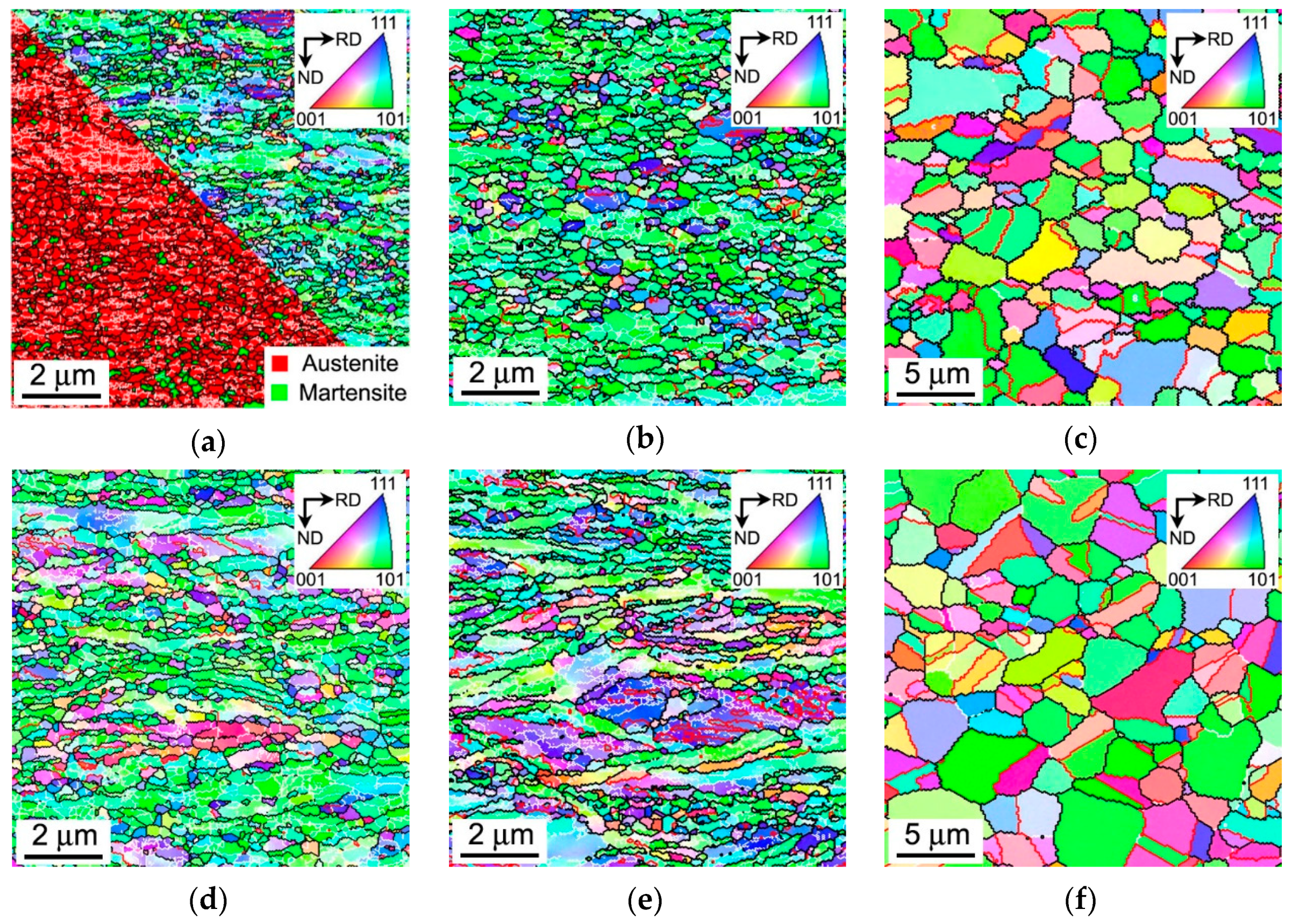
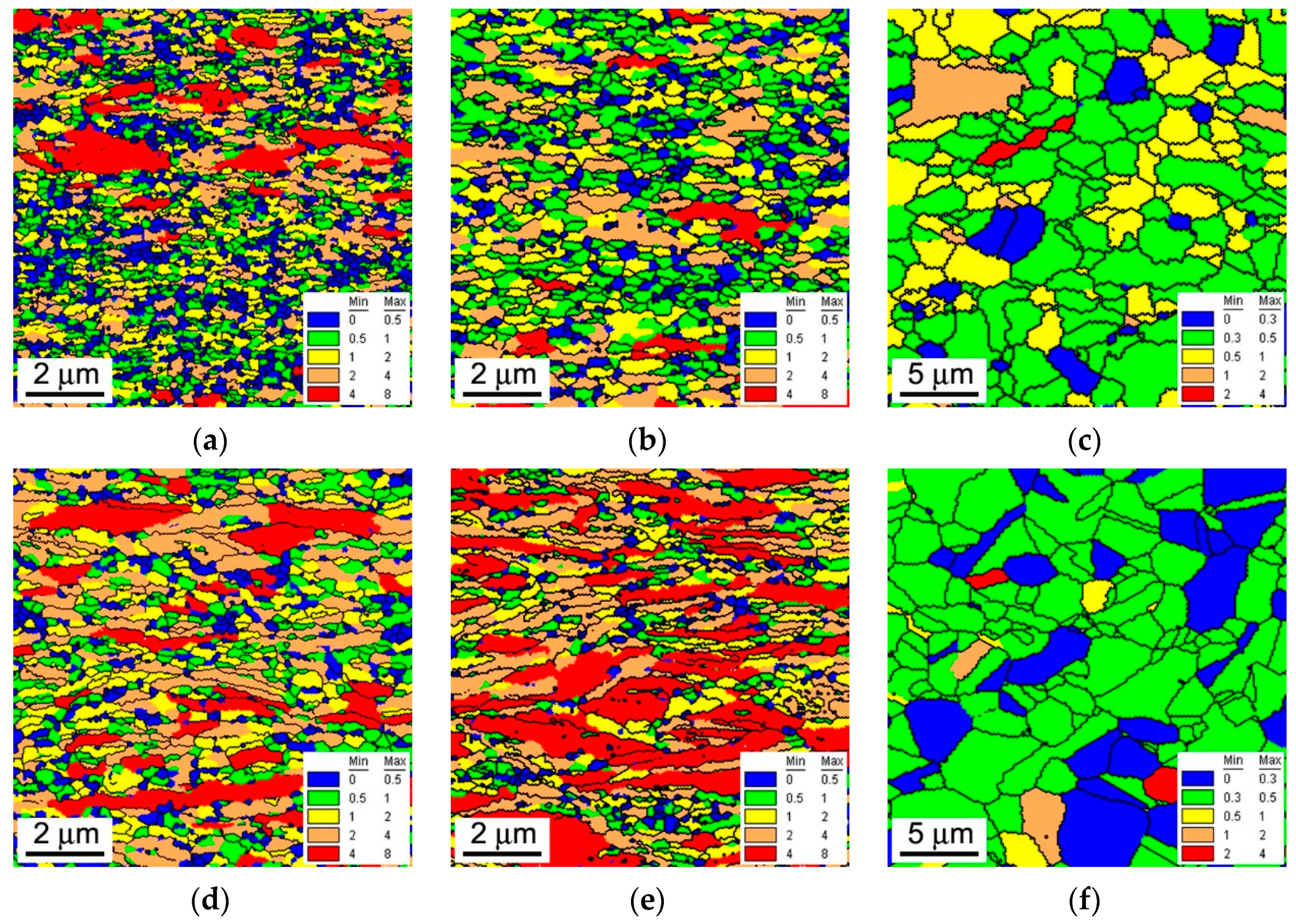
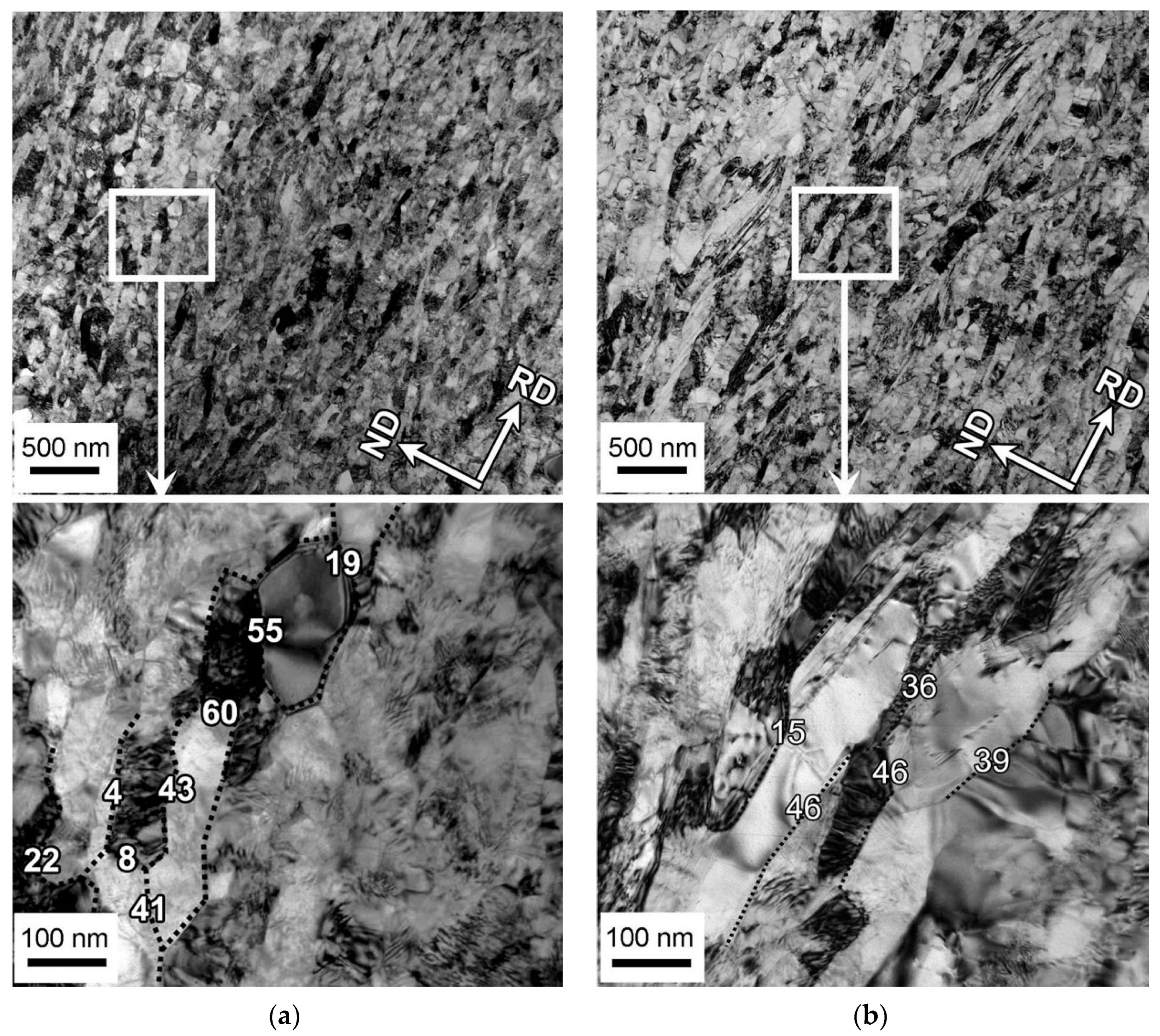
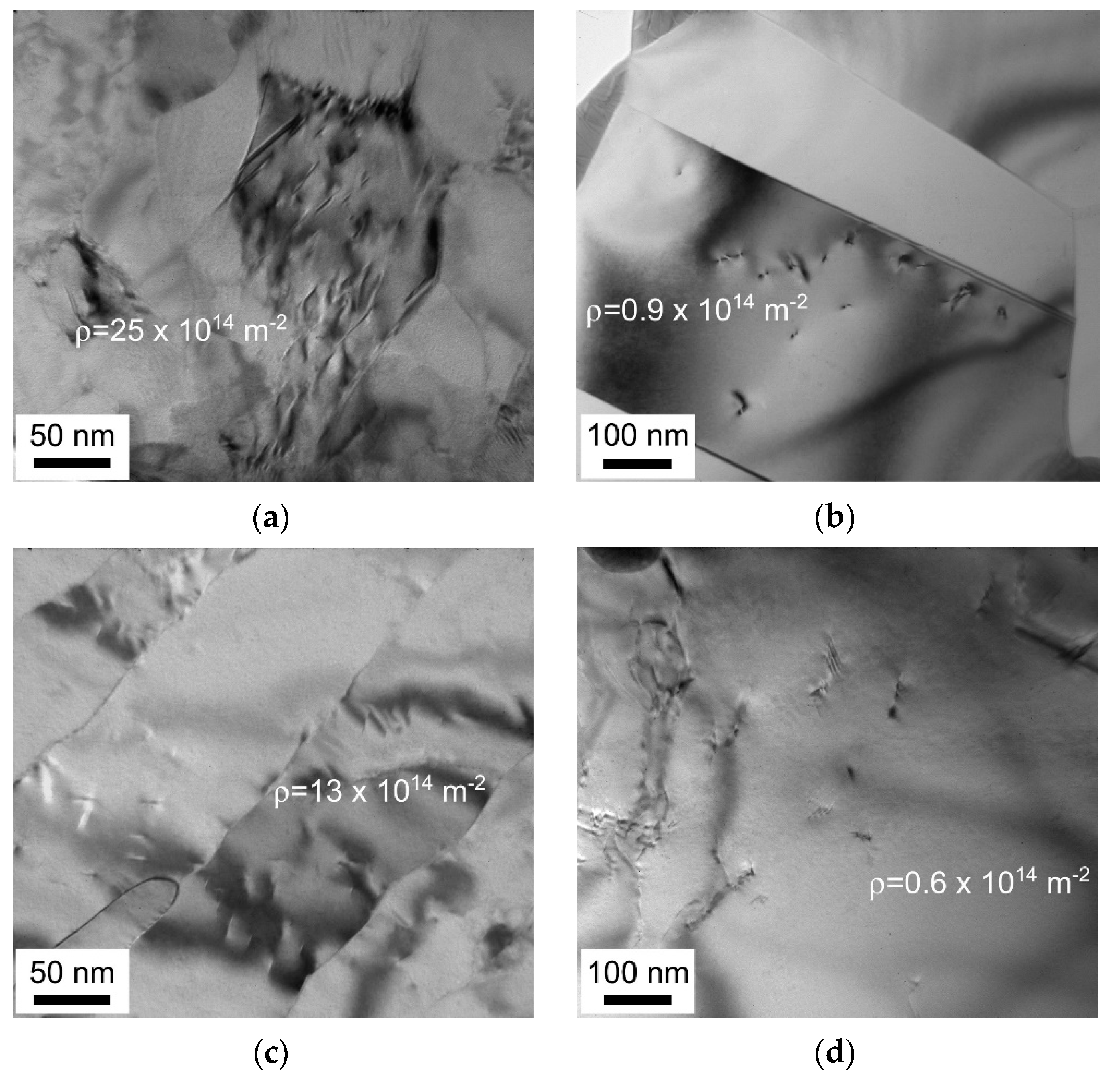

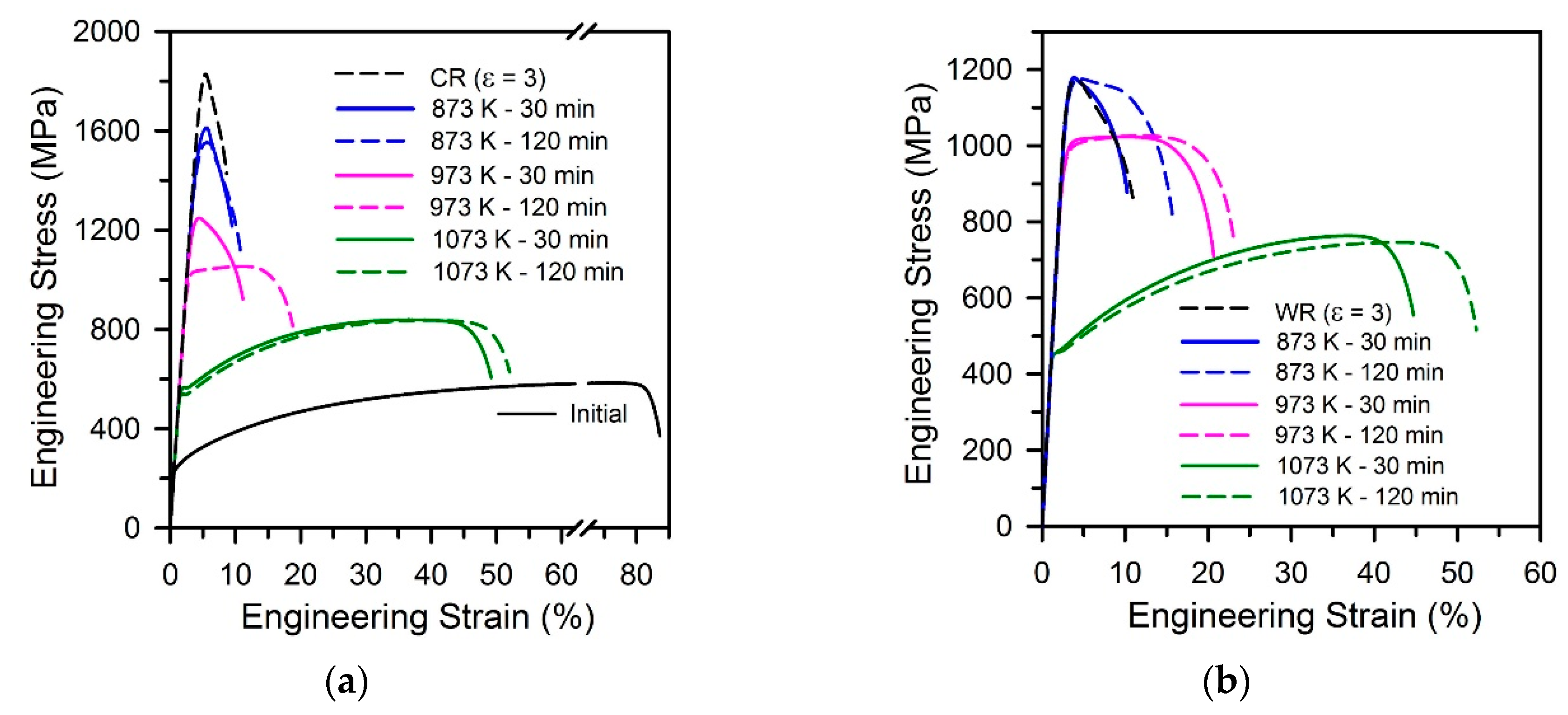
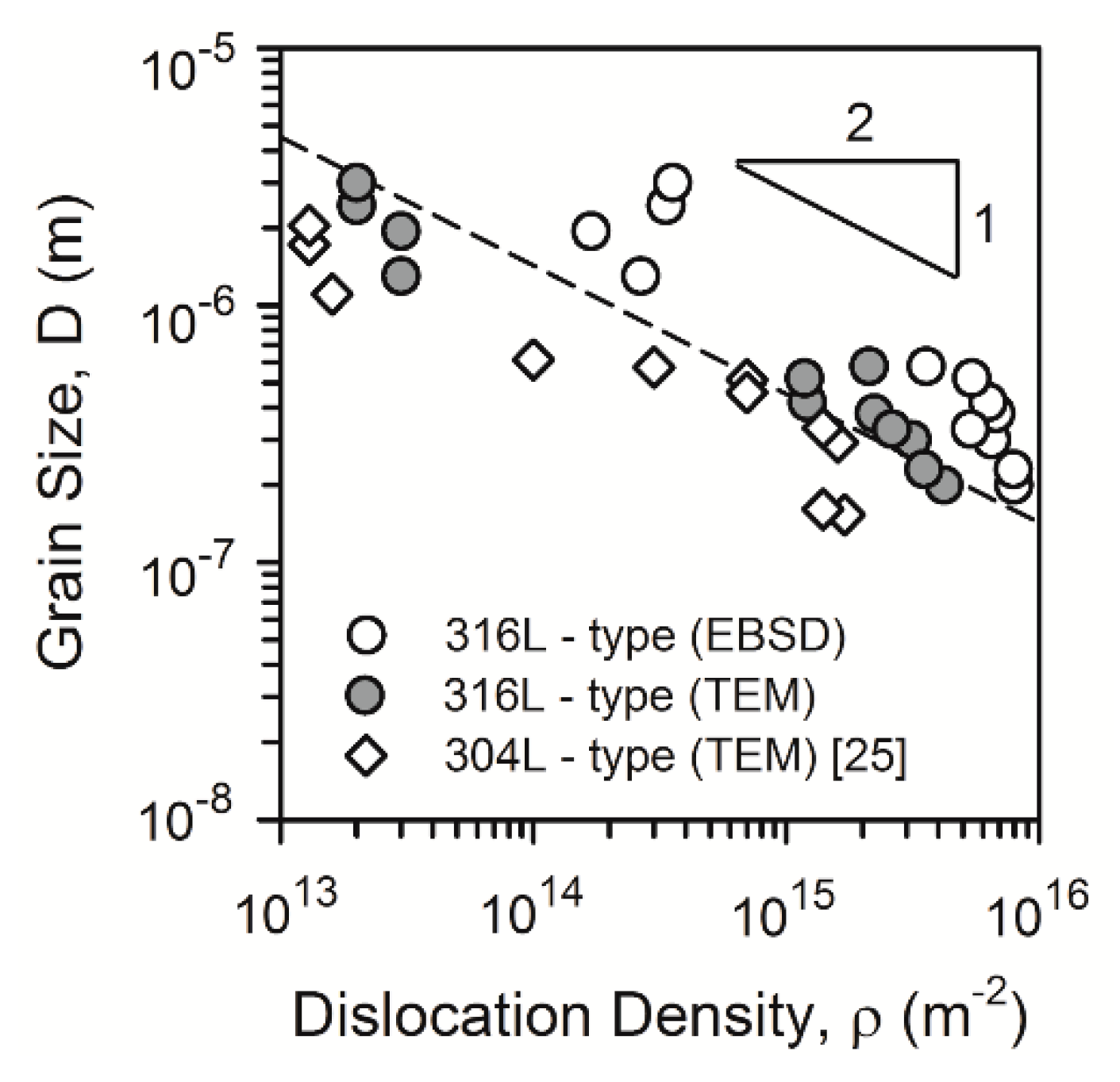
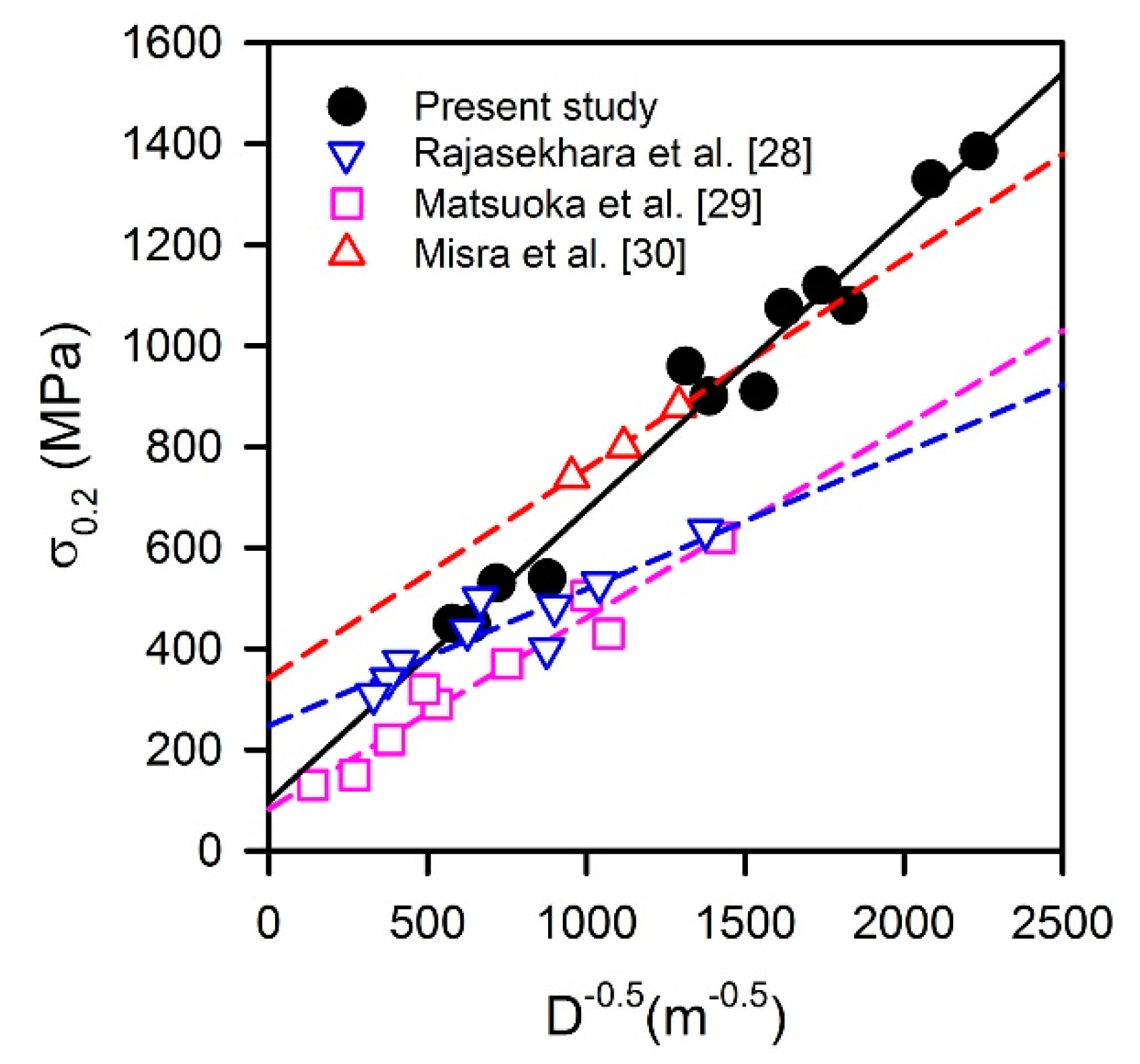
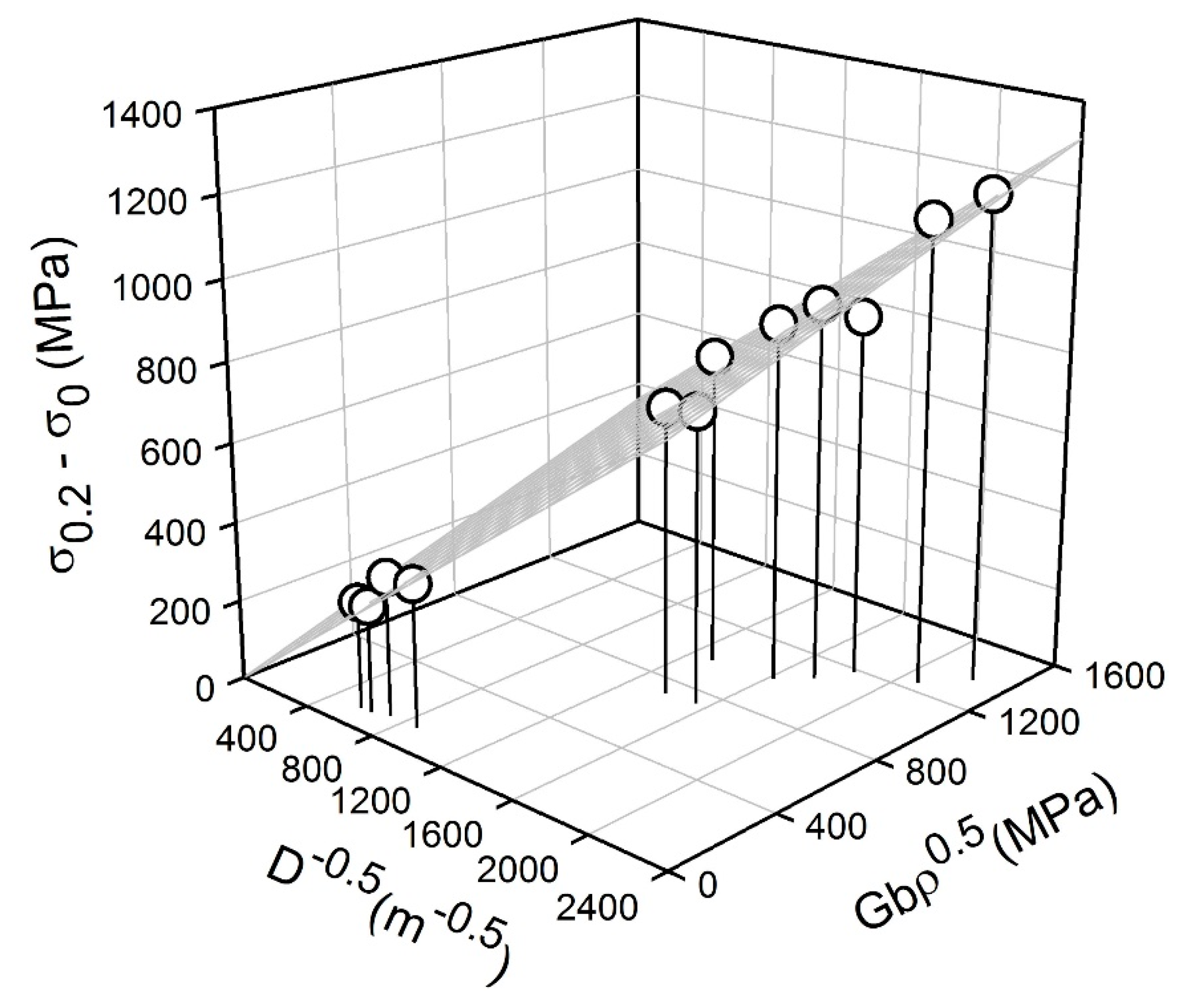

| Condition | D, μm | ρ, 1015 m−2 | σ0.2, MPa | UTS, MPa | δ, % |
|---|---|---|---|---|---|
| Initial | 21 ± 4 | 0.002 ± 0.001 | 235 ± 20 | 585 ± 20 | 86 ± 3 |
| CR + 873K (30 min) | 0.20 ± 0.02 | 4.21 ± 0.50 | 1385 ± 10 | 1630 ± 10 | 6 ± 2 |
| CR + 873K (120 min) | 0.23 ± 0.02 | 3.51 ± 0.40 | 1330 ± 10 | 1550 ± 10 | 8 ± 2 |
| CR + 973K (30 min) | 0.33 ± 0.03 | 2.62 ± 0.30 | 1120 ± 10 | 1250 ± 10 | 9 ± 2 |
| CR + 973K (120 min) | 0.58 ± 0.06 | 2.13 ± 0.30 | 960 ± 10 | 1055 ± 10 | 17 ± 2 |
| CR + 1073K (30 min) | 1.30 ± 0.15 | 0.03 ± 0.01 | 540 ± 10 | 840 ± 10 | 48 ± 3 |
| CR + 1073K (120 min) | 1.94 ± 0.20 | 0.03 ± 0.01 | 530 ± 10 | 835 ± 10 | 50 ± 3 |
| WR + 873K (30 min) | 0.30 ± 0.03 | 3.15 ± 0.50 | 1080 ± 10 | 1175 ± 10 | 8 ± 2 |
| WR + 873K (120 min) | 0.38 ± 0.04 | 2.23 ± 0.40 | 1075 ± 10 | 1175 ± 10 | 14 ± 2 |
| WR + 973K (30 min) | 0.42 ± 0.04 | 1.21 ± 0.30 | 910 ± 10 | 1025 ± 10 | 19 ± 2 |
| WR + 973K (120 min) | 0.52 ± 0.05 | 1.18 ± 0.30 | 900 ± 10 | 1025 ± 10 | 21 ± 2 |
| WR + 1073K (30 min) | 2.45 ± 0.25 | 0.02 ± 0.01 | 450 ± 10 | 760 ± 10 | 43 ± 3 |
| WR + 1073K (120 min) | 3.00 ± 0.30 | 0.02 ± 0.01 | 450 ± 10 | 745 ± 10 | 51 ± 3 |
| Material | Ky (MPa m0.5) | α | Reference |
|---|---|---|---|
| 304L austenitic stainless steel after cold rolling | 0.24 (experiment) | 0.73 (experiment) | [7] |
| Nickel after cold rolling | 0.158 (literature) | 0.72 (literature) | [19] |
| 316L Austenitic stainless steel after cold rolling | 0.047 (experiment) | 0.64 (experiment) | [23] |
| Aluminum after accumulative roll-bonding and annealing | 0.041 (experiment) | 0.72 (literature) | [35] |
| S304H austenitic stainless steel after warm-to-hot rolling | 0.12 (experiment) | 0.7 (experiment) | [36] |
| S304H austenitic stainless steel after cold rolling | 0.2 (experiment) | 0.77 (experiment) | [37] |
| 321 austenitic stainless steel after equal channel angle pressing and rolling | 0.3 (experiment) | 0.9 (literature) | [38] |
| Copper alloy after large strain warm deformation | 0.05 (experiment) | 1.0 (experiment) | [39] |
| 304 austenitic stainless steel after laser welding | 0.317 (literature) | 0.6 (literature) | [40] |
| Aluminum alloy after cold rolling and annealing | 0.045 (experiment) | 0.72 (literature) | [41] |
© 2020 by the authors. Licensee MDPI, Basel, Switzerland. This article is an open access article distributed under the terms and conditions of the Creative Commons Attribution (CC BY) license (http://creativecommons.org/licenses/by/4.0/).
Share and Cite
Odnobokova, M.; Yanushkevich, Z.; Kaibyshev, R.; Belyakov, A. On the Strength of a 316L-Type Stainless Steel Subjected to Cold or Warm Rolling Followed by Annealing. Materials 2020, 13, 2116. https://doi.org/10.3390/ma13092116
Odnobokova M, Yanushkevich Z, Kaibyshev R, Belyakov A. On the Strength of a 316L-Type Stainless Steel Subjected to Cold or Warm Rolling Followed by Annealing. Materials. 2020; 13(9):2116. https://doi.org/10.3390/ma13092116
Chicago/Turabian StyleOdnobokova, Marina, Zhanna Yanushkevich, Rustam Kaibyshev, and Andrey Belyakov. 2020. "On the Strength of a 316L-Type Stainless Steel Subjected to Cold or Warm Rolling Followed by Annealing" Materials 13, no. 9: 2116. https://doi.org/10.3390/ma13092116
APA StyleOdnobokova, M., Yanushkevich, Z., Kaibyshev, R., & Belyakov, A. (2020). On the Strength of a 316L-Type Stainless Steel Subjected to Cold or Warm Rolling Followed by Annealing. Materials, 13(9), 2116. https://doi.org/10.3390/ma13092116







